Online Magazine
Recent Posts
- Safeguard your Cellphone Photos
- Black & White to Color – Instantly
- Wearing Many Hats
- Video Roundup
- Rescuing Your Blurry Pictures
- Showing Their Age
- What is Your Angle?
- Panorama Photos
- Humorous Photos
- Close Ups
- Fisheye Pictures
- Photo Antiquities
- Printing Big
- Appreciating Scale
- Celebrity Sightings
Tags
More Places to Go
- Free "How-To" Books “How To” books for popular cameras 0
- Vist Us on Facebook keep in touch with us on Facebook 2
Archives
- July 2023 (1)
- March 2023 (2)
- February 2023 (1)
- December 2022 (1)
- October 2022 (1)
- September 2022 (8)
- August 2022 (9)
- July 2022 (1)
- June 2022 (1)
- June 2021 (1)
- May 2021 (1)
- March 2021 (5)
- February 2021 (4)
- January 2021 (2)
- April 2019 (1)
- March 2019 (1)
- February 2019 (1)
- October 2018 (2)
- April 2018 (1)
- March 2018 (4)
- February 2018 (1)
- November 2017 (1)
- August 2017 (1)
- June 2017 (1)
- April 2017 (1)
- March 2017 (5)
- February 2017 (2)
- January 2017 (1)
- October 2016 (1)
- September 2016 (1)
- August 2016 (1)
- July 2016 (1)
- May 2016 (1)
- April 2016 (1)
- March 2016 (2)
- February 2016 (1)
- January 2016 (2)
- December 2015 (1)
- November 2015 (1)
- October 2015 (3)
- April 2015 (1)
- March 2015 (5)
- February 2015 (1)
- January 2015 (4)
- December 2014 (2)
- November 2014 (5)
- October 2014 (2)
- September 2014 (1)
- August 2014 (2)
- July 2014 (1)
- May 2014 (1)
- April 2014 (5)
- March 2014 (5)
- December 2013 (2)
- November 2013 (18)
- October 2013 (1)
- September 2013 (1)
- August 2013 (1)
- July 2013 (1)
- June 2013 (3)
- May 2013 (1)
- April 2013 (2)
- March 2013 (1)
- February 2013 (1)
- January 2013 (1)
- December 2012 (1)
- November 2012 (2)
- October 2012 (2)
- September 2012 (5)
- August 2012 (2)
- July 2012 (1)
- June 2012 (1)
- May 2012 (1)
- April 2012 (4)
- March 2012 (1)
- February 2012 (1)
- January 2012 (3)
- December 2011 (1)
- November 2011 (3)
- October 2011 (1)
- September 2011 (2)
- August 2011 (2)
- June 2011 (3)
- May 2011 (4)
- April 2011 (8)
- March 2011 (8)
- February 2011 (10)
- January 2011 (6)
- December 2010 (11)
- November 2010 (14)
- October 2010 (6)
- September 2010 (12)
- August 2010 (2)
- July 2010 (4)
- June 2010 (3)
- May 2010 (1)
- April 2010 (1)
- March 2010 (2)
- February 2010 (1)
- January 2010 (1)
- December 2009 (1)
- November 2009 (2)
- October 2009 (2)
- September 2009 (1)
- August 2009 (3)
- July 2009 (2)
- June 2009 (1)
- May 2009 (2)
- April 2009 (1)
- March 2009 (2)
- February 2009 (1)
- January 2009 (3)
Flipbac Angle Viewfinder
21st April 2011
You’ve probably come across a situation where you find a great photo opportunity but you cannot frame the photo properly because something is blocking your view in the viewfinder. There might, for example, be a crowd of people, a fence, tall shrub, wall, etc., directly in your line of sight.
One way is to use a camera with a movable LCD monitor so you can snap photos at awkward angles. Unfortunately, most point-and-shoot cameras and digital SLRs don’t have a tilt-and-swivel LCD monitor. Therefore, you may want to consider attaching a Flipbac Angle Viewfinder to your camera.
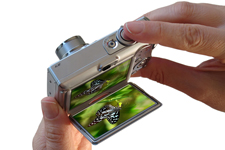 |
The Flipbac Angle Viewfinder help you compose shots at high and low angles. |
The Flipbac isn’t fancy; it’s simply a mirror attached to a small wire frame that you can swing a couple of different directions. It does do, however, what it says it will do. It’ll help you compose shots at difficult angles. It does this by reflecting the LCD image on its mirror-like surface, which simulates a screen that’s able to tilt. You can use the Flipbac in either landscape or portrait mode.
(more…)
Easy Panoramas
17th April 2011
Nothing Beats The Simplicity of In-Camera Panoramas
When you want to take it all in, a panorama is a fun way to recreate a memorable view.
Most panoramas are made by taking multiple photos and painstakingly stitching them together with specialized computer software.
Over the years I’ve put together many such panoramas. Since I’ve made so many, I know the routine by heart. I usually build a panorama from six to ten separate images.
First I set the camera shutter speed and aperture manually so that the lighting remains constant throughout all of the images. Since altering the focus point between shots makes it almost impossible to later stitch the photos together, I also set the focus to manual and choose a focus distance for the most important part of the scene. To make sure that the horizon remains level in all of the exposures, I use a tripod and bubble level. To keep track of the images in a set, I place my hand over the lens and shoot to indicate that the next photo is the start of a panorama. After each exposure, I rotate the tripod head so that the next exposure overlaps the previous one by about 30%.
(more…)
Landscape Or Portrait: it’s your choice
24th November 2010
Are you in the habit of holding your camera horizontally? Although it’s fine to shoot horizontally (called the landscape orientation) in many situations, keep in mind that holding your camera differently can dramatically change the impact of the photo. Have you, for example, turned your camera 90-degrees so you’re shooting vertically (called the portrait orientation)?
Look at these two photographs of the same sunrise scene. The photo on the left is horizontal (landscape) and shows plenty of the lake near the edges but not as much of the sunrise. The photo on the right is vertical and emphasizes the sunrise and the rays of the sun on the water much better.
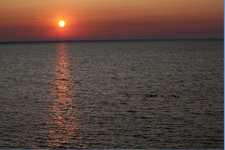 Sunrise scene in horizontal (landscape) |
 Same sunrise scene but vertical (portrait) |
Although it can be a little awkward at first to hold the camera vertically, you may be amazed at the difference it can make to the photo. This is especially true if you’re taking a photo of one person. It’s almost a crime not to shoot vertically in these situations because otherwise you’re wasting so much of the photo area at the edges.
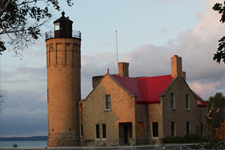 The Old Mackinac Point Lighthouse |
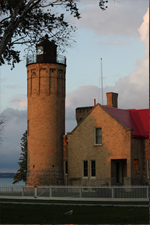 The same lighthouse but vertical |
Even when you are shooting landscapes, you will find that, sometimes, the picture will look more dynamic when you hold your camera vertically.
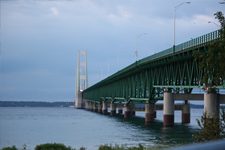 The Mackinac Bridge horizontal |
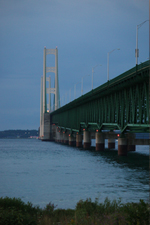 The same scene but vertical |
Whether to shoot vertical or horizontal is all about experimenting which is easy to do with your digital camera. So the next time you’re holding your camera horizontally and take a photo, turn the camera 90 degrees and take the same photo again vertically. Then decide which one you like better.
Written by Scott Slaughter
« Older Posts — Newer Posts »